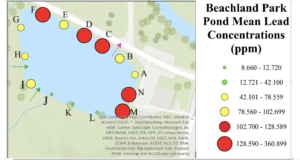Lead Concentration a Concern in Urban Ponds, Trinity College Study Finds
The very reason urban public ponds are coveted is also a reason they may be contaminated, according to a Trinity College study of Hartford ponds.
Communities value these waterbodies for their access to nature amid a built area. They reduce the urban heat island effect, a consequence of abundant heat-trapping impervious surfaces such as asphalt or concrete. But the runoff from these surfaces may make the quality of water off limits to humans and wildlife.
“Lead concentrations in mixed use urban park ponds that serve as stormwater catchment, recreational sites, and wildlife habitat may reach unsafe levels, rendering the ponds unsuitable for recreational use and wildlife,” according to the Trinity team that published their study in the January Springer journal Urban Ecosystems.
In the study, researchers examined the sediment and water quality in two Hartford area waterbodies: Keney Park Pond and Beachland Park Pond. Fourteen sediment samples were taken each from the most heavily trafficked areas of the pond perimeter.
The research team included Amber Pitt, associate professor of environmental science, Arianne Bazilio, assistant professor of environmental science and chemistry, and Trinity alumni Olivia Mastrangelo ’23, and Isaac Frank ’23.
 Researchers found the levels of lead concentrations varied from pond to pond and from location to location within each pond. Keney Park Pond was within the range deemed healthy, while Beachland Park Pond had elevated lead levels.
Researchers found the levels of lead concentrations varied from pond to pond and from location to location within each pond. Keney Park Pond was within the range deemed healthy, while Beachland Park Pond had elevated lead levels.
The uneven distribution of lead was likely a reflection of the pond characteristics including the presence of features such as drainage connections for stormwater runoff, which often contains lead, they said. Overall, Beachland Park has less surrounding greenspace and broader stormwater management connections than Keney Park Pond, noted the authors.
Ultimately, the two ponds studied offer information that can be used by park managers and public planners overseeing these valuable resources, the authors say. When designing urban ponds with inflows from stormwater catchments, planners should consider pollution mitigation techniques.
The ponds offer a value that is worth protecting.
In addition to providing access to nature, urban ponds often have the benefit of adding monetary value to surrounding properties, supporting fish populations that serve as sources for food, and providing water for irrigation.
